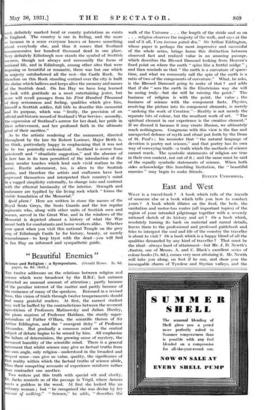" Beautiful Enemies " THE twelve addresses on the relations
between religion and science which were broadcast by the B.B.C. last autumn ttracted an unusual amount of attention ; partly because f the peculiar interest of the matter and partly because of the eminence of many of the speakers. Reissued in a revised orm, this vision of truth through twelve temperaments should nd many grateful readers. At first, the earnest student lay well be baffled by the contradictions between the reverent osticism of Professors Malinowsky and Julian Huxley, he pious monism of Professor Haldane, the sturdy super- aturalism of Father O'Hara, the scientific theism of Sir rthur Eddington, and the " emergent deity " of Professor lexander. But gradually a common mind on the central abject of debate begins to be sensed by him. All emphasize he failure of determinism, the growing sense of mystery, the ncreased humility of the scientific mind; There is a general greement that whilst science may give us factual truths from er own angle, only religion—understood in the broadest and eepest sense—can give us value, quality, the significance of hat reality within which the factual truths of science abide, us their competing accounts of experience reinforce rather han contradict one another.
Two writers put this truth with special wit and clarity. r. Jacks reminds us of the passage in Virgil, where Aeneas eets a goddess m the wood. At first she looked like an ordinary woman ; but " he recognized she was divine by lfer coiner of walking." " Science," be adds; " describes the walk of the Universe . . . the length of the stride and so on . . . religion observes the majesty of the walk, and says at the end of it all, Vera incessu patuit dea." Sir Arthur Eddington, whose paper is perhaps the most impressive and successful of the whole series, brings home this distinction between observed fact and realized value in an amusing passage, which describes the Blessed Damozel looking from Heaven's fixed point on where the earth " spins like a fretful midge " ; and then reminds us that " the earth is a curvature of space- time, and what we commonly call the spin of the earth is a ratio of two of the components of curvature." What, he asks, is the Blessed Damozel going to make of that ? and adds that if she " sees the earth in the Einsteinian way she will be seeing truly—but she will be missing the point." The business of religion is with the point, the value ; the business of science with the component facts. Physics, resolving the picture into its component elements, is merely " undoing the work of Creation "—Reality is not merely the separate bits of colour, but the resultant work of art. " The spiritual element in our experience is the creative element." If we discard it because it may create illusion, we ultimately reach nothingness. Congruous with this view is the fine and unexpected defence of myth and ritual put forth by the Dean of St. Paul's ; his reminder that " the natural language of devotion is poetry not science," and that poetry has its own way of conveying truth—a truth which the methods of science cannot reach.. The symbolic statements of religion are true in their own context, not out of it ; and the same must be said of the equally symbolic statements of science. When both sides acknowledge this humbling limitation, the " beautiful enemies " may begin to make friends.
EVELYN UNDERHILL.






































 Previous page
Previous page